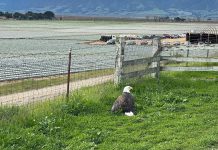
JOLON — Fort Hunter Liggett recently conducted a groundbreaking ceremony to build a $21.6 million electrical microgrid, which will make it the first Army installation to achieve Net Zero for critical operations.
That means it will be capable of generating and distributing electricity for 14 days of energy resiliency. It is an important first step in scaling this type of energy self-sufficiency throughout the Department of Defense.
“This microgrid expansion will allow us to reach our Net Zero goals by 2022,” said Col. Charles Bell, FHL garrison commander, at the May 27 ceremony. “Although we’re an Army Reserve installation, we see a lot of activity from the active Army, Navy, Special Warfare Group, and it’s critical that we’re able to continue to provide this platform to all these units that train here.”
FHL’s energy, waste and water resiliency and sustainability projects have earned high-level attention in the past decade, and thus, been selected as part of a handful of installations to provide a White House Virtual Tour to showcase its accomplishments.
“Holistically, we have one of the most forward-leaning energy programs,” said Jarrod Ross, resource efficiency manager for FHL. “We have become an example for the Army to hold up as far as what could be accomplished. However, FHL would have never reached this achievement without the exceptional level of technical and budgetary support from the Army Reserve Installation Management Directorate, Sustainment and Resiliency Division, which has long championed these efforts.”
A microgrid is a self-contained electrical distribution system capable of operating in the absence of the utility grid. The following will be involved:
- The solar array at the Equipment Concentration Site will be expanded, and additional photovoltaic (solar) generation will be installed at the O&M yard where the groundbreaking took place;
- Power will be stored in batteries so that electricity generated during the day can be distributed at night;
- The medium voltage distribution system was upgraded and buried underground in the cantonment several years ago in anticipation of this resiliency project; and
- The entire microgrid system will be governed by an automated Supervisory Control and Data Acquisition (SCADA) system that can respond to changes in grid conditions in as little as 1/30th of a second when needed.
Once finished, the system, designed and to be installed by Ameresco, Inc., will generate more electricity than FHL can consume over a 12-month period, Ross noted.
“This means Fort Hunter Liggett will have satisfied an Army and DoD goal for achieving electrical Net Zero,” Ross said.
That does not mean that FHL can fully disconnect from the power grid, since Net Zero is an average, not a daily capacity.
“We’d export more electricity during the summer and import more in the winter,” Ross said. “It averages out and the net amount is zero.”
Even with the battery energy storage included in this contract, FHL will not have enough batteries to store every kilowatt of electricity generated by the system.
Several years ago, DoD realized the need to conserve energy, avoid overtaxing the grid and adapt to climate change. It began finding ways to reduce energy use by making buildings, utilities and lighting systems more efficient, Ross explained.
“Around 2013-14, they moved to the Net Zero concept to reduce consumption by installing renewables, and then beginning in 2017 the Department of the Army expanded the goal to include Mission Resilience,” Ross said.
FHL is one of the nine Net Zero Initiative pilot installations selected by the Assistant Secretary of the Army for Installations, Energy and Environment.
“I think it’s going to be at the tip of the spear of energy resilience initiatives that the DoD and the Department of Army are working to achieve,” said John Moreno, Senior Executive Service and regional business director, U.S. Army Corps of Engineers South Pacific Division.
Article submitted by Cynthia McIntyre, Public Affairs Specialist for Fort Hunter Liggett.














